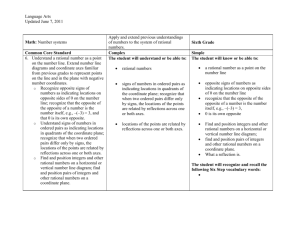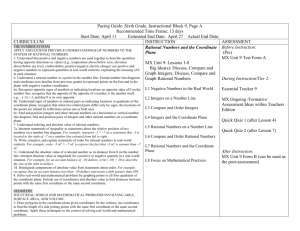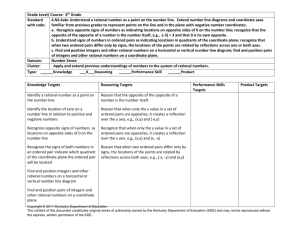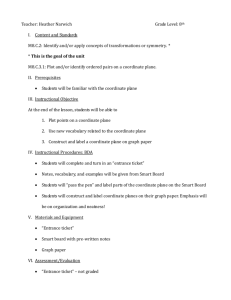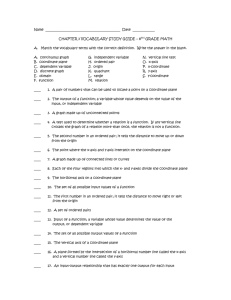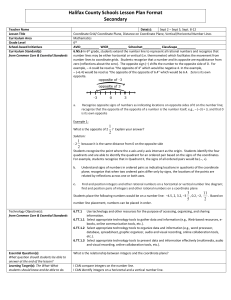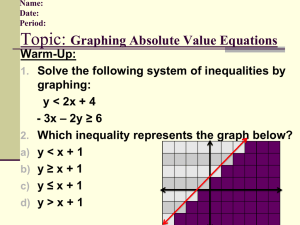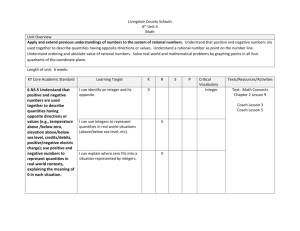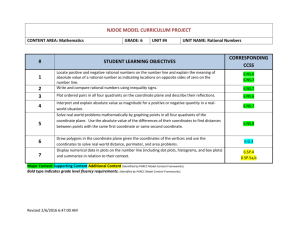6th Grade Math Number System Part 2 Unit
advertisement
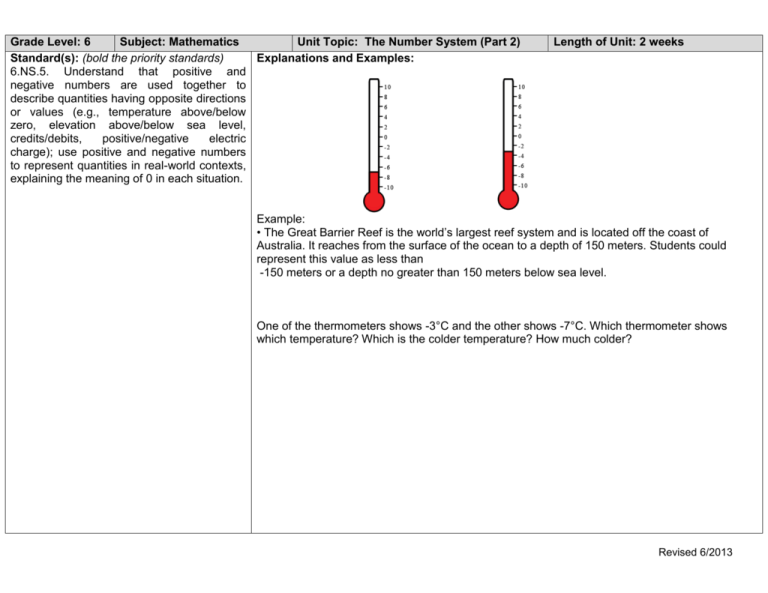
Grade Level: 6 Subject: Mathematics Unit Topic: The Number System (Part 2) Standard(s): (bold the priority standards) Explanations and Examples: 6.NS.5. Understand that positive and negative numbers are used together to describe quantities having opposite directions or values (e.g., temperature above/below zero, elevation above/below sea level, credits/debits, positive/negative electric charge); use positive and negative numbers to represent quantities in real-world contexts, explaining the meaning of 0 in each situation. Length of Unit: 2 weeks Example: • The Great Barrier Reef is the world’s largest reef system and is located off the coast of Australia. It reaches from the surface of the ocean to a depth of 150 meters. Students could represent this value as less than -150 meters or a depth no greater than 150 meters below sea level. One of the thermometers shows -3°C and the other shows -7°C. Which thermometer shows which temperature? Which is the colder temperature? How much colder? Revised 6/2013 6.NS. 6. Understand a rational number as a point on the number line. Extend number line diagrams and coordinate axes familiar from previous grades to represent points on the line and in the plane with negative number coordinates. a. Recognize opposite signs of numbers as indicating locations on opposite sides of 0 on the number line; recognize that the opposite of the opposite of a number is the number itself, e.g., –(–3) = 3, and that 0 is its own opposite. b. Understand signs of numbers in ordered pairs as indicating locations in quadrants of the coordinate plane; recognize that when two ordered pairs differ only by signs, the locations of the points are related by reflections across one or both axes. c. Find and position integers and other rational numbers on a horizontal or vertical number line diagram; find and position pairs of integers and other rational numbers on a coordinate plane. 6.NS. 6. Number lines can be used to show numbers and their opposites. Both 3 and -3 are 3 units from zero on the number line. Graphing points and reflecting across zero on a number line extends to graphing and reflecting points across axes on a coordinate grid. The use of both horizontal and vertical number line models facilitates the movement from number lines to coordinate grids. 6.NS.7. Understand ordering and absolute value of rational numbers. a. Interpret statements of inequality as statements about the relative position of two numbers on a number line diagram. For example, interpret –3 > –7 as a statement that –3 is located to the right of –7 on a number line oriented from 6.NS.7. Common models to represent and compare integers include number line models, temperature models and the profit-loss model. On a number line model, the number is represented by an arrow drawn from zero to the location of the number on the number line; the absolute value is the length of this arrow. The number line can also be viewed as a thermometer where each point of on the number line is a specific temperature. In the profit-loss model, a positive number corresponds to profit and the negative number corresponds to a loss. Each of these models is useful for examining values but can also be used in later grades when students begin to perform operations on integers. Example: • Graph the following points in the correct quadrant of the coordinate plane. If you reflected each point across the x-axis, what are the coordinates of the reflected points? What similarities do you notice between coordinates of the original point and the reflected point? 1 (12 , −3 2) (− 12 , −3 ) (0.25, -0.75) Revised 6/2013 left to right. b. Write, interpret, and explain statements of order for rational numbers in real-world contexts. For example, write –3 C > – 7 C to express the fact that –3 C is warmer than – 7 C. c. Understand the absolute value of a rational number as its distance from 0 on the number line; interpret absolute value as magnitude for a positive or negative quantity in a real-world situation. For example, for an account balance of -30 dollars, write /-30/ = 30 to describe the size of the debt in dollars. Distinguish comparisons of absolute value from statements about order. For example, recognize that an account balance less than – 30 dollars represents a debt greater than 30 dollars. In working with number line models, students internalize the order of the numbers; larger numbers on the right or top of the number line and smaller numbers to the left or bottom of the number line. They use the order to correctly locate integers and other rational numbers on the number line. By placing two numbers on the same number line, they are able to write inequalities and make statements about the relationships between the numbers. Case 1: Two positive numbers 5>3 5 is greater than 3 Case 2: One positive and one negative number 3 > -3 positive 3 is greater than negative 3 negative 3 is less than positive 3 Case 3: Two negative numbers -3 > -5 negative 3 is greater than negative 5 negative 5 is less than negative 3 Comparative statements generate informal experience with operations and lay the foundation for formal work with operations on integers in grade 7. Example: • One of the thermometers shows -3°C and the other shows -7°C. Which thermometer shows which temperature? Which is the colder temperature? How much colder? Write an inequality to show the relationship between the temperatures and explain how the model shows this relationship. 6.NS.8 Solve real-world and mathematical 6.NS.8 Example: If the points on the coordinate plane below are the three vertices of a problems by graphing points in all four rectangle, what are the coordinates of the fourth vertex? How do you know? What are the length quadrants of the coordinate plane. Include and width of the rectangle? use of coordinates and absolute value to find distances between points with the same first coordinate or the same second coordinate. Revised 6/2013 Concepts:(What students need to know) rational numbers o integers o opposites o absolute value absolute value as magnitude o order for rational numbers in real-world contexts number line diagrams o relative position of two numbers on a number line diagram o distance from 0 on the number line coordinate plane o quadrants o ordered pairs/coordinates o reflections To determine the distance along the x-axis between the point (-4, 2) and (2, 2) a student must recognize that -4 is |−4| or 4 units to the left of 0 and 2 is |2| or 2 units to the right of zero, so the two points are total of 6 units apart along the x-axis. Students should represent this on the coordinate grid and numerically with an absolute value expression, |−4| + |2|. Skills:(What students need to be able to do) Blooms / DOK Levels: 2 UNDERSTAND o (rational numbers as points on numbers lines) o (ordered pairs as locations in coordinate plane) o (absolute value as distance on number line) 2 REPRESENT (points on number lines and coordinate plane) 2 RECOGNIZE (opposites) 2 FIND/POSITION (points on number lines and coordinate planes) 2,3 ORDER (rational numbers) 2 WRITE and EXPLAIN (statements of order/real world context) INTERPRET (relative position on number line) Essential Questions: (Open-ended questions that the students should be able to answer by the end of the unit) What are integers? What are negative numbers? How can I use a number line to determine a number’s opposite? In a real life situation, how can I tell if positive or negative numbers are involved when I am figuring out a problem? Corresponding Big Ideas: (Foundational understandings that students need to discovered by the end of the unit) Understand the absolute value of a rational number as it relates to a number line. Interpret absolute value as magnitude for a positive or negative quantity in a real-world situation. Distinguish comparisons of absolute value from statements about order. Revised 6/2013 What is a rational number? What is a coordinate plane? How can I find, identify or place a point on the coordinate plane? What is a quadrant on the coordinate plane? What is absolute value? Vocabulary: Integers Absolute value Rational number Quadrant Coordinates Reflection Origin X-axis Y-axis Solve mathematical and real-world problems using all four quadrants of the coordinate plane. A system of two number lines is called a coordinate plane: the horizontal line is called the x-axis and the vertical line is called the yaxis. A point on the the coordinate plane can be described by its distance along both number lines. An ordered pair (x,y) is used to locate that point. When the axes are extended in both directions, they divide the coordinate plane into 4 parts, called quadrants. Mathematical Practices: Resources: (Practices in bold are to be emphasized in http://www.illustrativemathematics.org the unit.) http://www.sde.ct.gov/sde/cwp http://www.smarterbalanced.org 1. Make sense of problems and persevere http://ims.ode.state.oh.us in solving them. http://www.insidemathematics.org 2. Reason abstractly and quantitatively. http://www.utah.edu 3. Construct viable arguments and critique http://www.mathematicsresourcesassessment.com the reasoning of others. http://northbaymathproject.org 4. Model with mathematics. http://www.pinterest.com 5. Use appropriate tools strategically. http://www.youtube.com 6. Attend to precision. http://www.engageny.org 7. Look for and make use of structure. http://www.hoodamath.com/games/sixth-grade.html 8. Look for and express regularity in http://www.arcademicskillbuilders.com/games/orbitrepeated reasoning. integers/orbit-integers.html http://www.mathplayground.com/thinkingblocks.html http://www.math-play.com/Factors-and-MultiplesJeopardy/Factors-and-Multiples-Jeopardy.html http://www.state.nj.us/education http://www.livebinders.com Assessment for Learning: (How do you know the student has mastered the standards? Include both Pre and Post Assessments) Unit 2 Pre-Test.docx Pre Assessment Post Assessment Unit 2 Post Assessment.docx Test Scoring Guide Unit 2 Post Test Rubric.docx Revised 6/2013 Task 1. 2. Engaging Learning Experiences Description: (Standards addressed, Blooms / DOK Levels, links to rubric, resources, instructional strategies, etc.) 6.NS.5, DOK 1, rubric in document, http://northbaymathproject.org Suggested Length of Time 50 min. 6NS5 Task 1 DOK 1.docx 6.NS 5, DOK 3, rubric in document, www.illustrativemathematics.com 40 mins. 6.NS 5 and 7, DOK 2, rubric in document, www.illustrativemathematics.com 50 mins, NS 5 Warmer in Miami.docx Sea Level Task.docx 3. 6.NS 6, DOK 2, rubric in document, www.utah.gov/education 2 days at 45 mins. Integer Task.pdf 4. 5. 6. 7. 6.NS 7, DOK 3, rubric in document, www.illustrativemathematics.com 50 mins. 6.NS 7, DOK 3, rubric in document, www.illustrativemathematics.com 50 mins. 6.NS 8, DOK 2/3, rubric in document, www.insidemathematics.org 50 mins. Integers on the Number Line.pdf Comparing temperatures.pdf Granny's Balloon Trip NS.8.pdf Revised 6/2013
